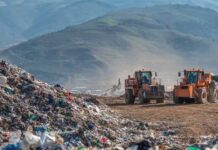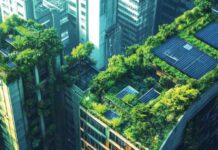
The US Green Building Council (USGBC) is committed to transforming the way buildings are designed, constructed and operated through LEED — the top third-party verification system for sustainable structures around the world. Mahesh Ramanujam, President and Chief Executive Officer, USGBC talks about potential of green buildings concept, services offered by USGBC in India, challenges, opportunities generated due to the Government’s smart cities initiatives and much more in an exclusive interview with Supriya Oundhakar…
With emphasis on zero carbon footprint, how do you envisage the growth of green buildings concept in India?
I believe that India is positioning
itself to become a global leader in sustainability. The concept of
sustainability is not new to India – it’s a mission grounded in the core
beliefs of Indians everywhere.
At USGBC, we work towards market
transformation for the built environment through the globally recognized
Leadership in Energy and Environmental Design (LEED) program. A global,
regional and local green building rating system, LEED is a market
transformation tool that helps us build green, healthy and sustainable
buildings and communities.
LEED is a key solution to India’s
current environmental challenges and a tool that improves human health. India
has shown tremendous leadership in the green building movement and is now the
third largest market for LEED outside the US. There are a number of companies
in India that are looking to LEED as a way to dramatically reduce their water
and energy use, reduce the carbon footprint of their business practices and
impact their triple-bottom line.
While LEED is an important
transformative tool that has been widely adopted in India, there is still work
to be done in order to ensure a sustainable future for all and continue to
scale up the number of green buildings. India must adopt smart city and smart
grid policies, implement technologies that improve the performance of our
cities, continue the transition from the concept of green buildings to green
cities, and incorporate wellness and sustainable sites into city planning and
development.
USGBC has LEED services hub in India.
What kind of services is it offering to Indian green building market?
This year, we announced the
incorporation of Green Business Certification Inc. (GBCI), the premiere
organization independently recognizing excellence in green business industry
performance and practice globally, in India. The new GBCI office, located in
Gurgaon, will serve to facilitate the global growth of GBCI and its
sustainability programs. We will be able to continue our efforts to green the
built environment in India and across the globe, with new added support and
on-the-ground capabilities. GBCI exclusively administers project certifications
and professional credentials and certificates of LEED, WELL, PEER, Parksmart,
SITES, GRESB and other sustainability programs.
What are the challenges faced by you in Indian markets? How do you overcome the same?
We have been in India for a long time – more than 14 years. Even with that level of commitment, there are still challenges that we face. The biggest challenge has been distance. As the green building industry has grown, the competition has intensified. It can be hard for anyone to compete locally from half a world away. To overcome that challenge, we incorporated GBCI in India. In doing so, we addressed concerns not only about distance, but also about local market commitment, rating-system relevance, customer service and even currency exchange rate. Our being here demonstrates our commitment to India in every respect. We are here to contribute and we are committed to India’s future.
What are the opportunities generated for you with Indian government’s launch of ‘100 smart cities’ project? Please elaborate.
USGBC has a strong vision of a sustainable built environment within a generation and we are transforming the communities where we live, work, learn and play. The vision is simple—that buildings and communities will regenerate and sustain the health and vitality of all life. USGBC believes that vision is only possible through the development of smart cities at a global scale, and the Indian government’s Smart Cities initiative is helping to facilitate much needed progress.
In support of our vision, we also recently released two new pilot certification programs – LEED for Cities and LEED for Communities – that asks a community or city to set goals, and implement strategies and plans to maintain and support the goals. The city or community then shares performance data to measure and track progress. LEED for Cities and LEED for Communities will support continuous progress towards better communities and cities, and a higher quality of life. They are very much in line with the Smart Cities objectives.
While LEED is an important transformative tool that has been widely adopted in India, there is still work to be done in order to ensure a sustainable future for all and continue to scale up the number of green buildings.
What are sustainable design considerations adopted during the construction of green buildings? How would you achieve the goal of energy efficiency during the construction of buildings?
We live in a resource-constrained world
and in no area is this more evident than with regard to our energy system.
Energy is a critical economic issue and a top priority for the government in
India, and buildings are at the front line of this issue because they account
for roughly 40 percent of the total energy used today.
To increase energy efficiency during
the construction of buildings, you must first address the envelope of a
building and minimize unwanted heat gain or loss, using the regionally
appropriate amount of insulation for your building. Other strategies that can
be used are incorporating natural daylighting, installing high-efficiency
infrastructure such as efficient mechanical and lighting systems and utilizing
renewable energy. Post-construction, it is important that you monitor and
verify the performance of a building to ensure that the building systems are
functioning as designed and support your project requirements.
What are the services offered by USGBC suiting to Indian geographical conditions and standards? What is the research involved to understand India requirements?
LEED is the only
globally consistent green building rating tool. This consistency provides
a platform to share the best practice in building around the world. However,
because environmental and climate conditions, codes, standards and laws vary in
different places, USGBC has developed Alternative Compliance Paths (ACPs) to
recognize those differences while achieving the same credit intent
and requirements.
ACPs increase the applicability of LEED
for projects in India and around the world by providing additional pathways to
demonstrate compliance with the LEED credits that are traditionally more
challenging for projects outside of the US. By focusing on global and
regional standards and solutions, these ACPs make LEED increasingly flexible
and ensure a common language for all green buildings.
Green buildings concept costs more than conventional buildings. So, developers usually do not adopt the latest green technologies? What is the way through which this technology can be incentivized?
The economics of building green have
changed dramatically and in ways that are very favorable to green builders.
Unlike 10 or even five years ago, green building is happening on such a scale
that, when properly planned, the up front costs are more often lower than they
are for conventional projects. And this is due to the fact that over the last
two decades, LEED certification has become a symbol of leadership, signifying
that a project is saving energy, resources and water.
Leaders in India and across the globe
also understand that LEED is a powerful market tool that works. These leaders
recognize that LEED enhances a company’s triple-bottom line, helps organizations
manage their business operations and creates a more sustainable,
energy-efficient built environment. What we are hearing from many of our
clients is that over the life of a building, costs are recouped as quickly two
to three years.
Any building project or developer can access the latest and most innovative technologies. I think that people working on green projects pay more attention to details related to building performance and environmental impact. If people do their homework and plan properly, they can incorporate products and strategies using the latest technologies that produce significant cost savings, dramatically reduce environmental impacts and encourage energy efficiency.

What are your expectations from the Indian Government for supporting the green building concept?
India is a booming market for green building, and that’s largely because of programs put in place by the Indian Government. Prime Minister Modi launched the Smart Cities Intiative himself, which was a remarkable demonstration of support. The Indian Government is really helping to create demand for green buildings and we predict this growth will continue. Green building in India are projected to grow by 20 percent over the next three years.
LEED has been a part of the Indian green building movement since its earliest days. The first green building in India was a LEED certified building. So, I would say our expectations for growth are very high, but we do not take our relationship with India lightly nor do we take it for granted. We are strongly committed to India.
If you want to share thoughts or feedback on this article, please leave a comment below.








